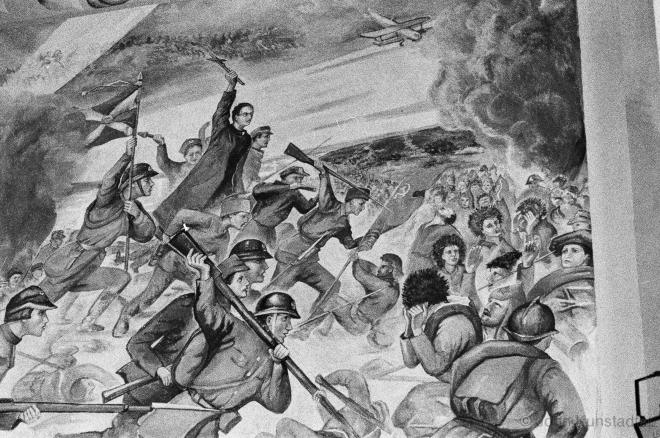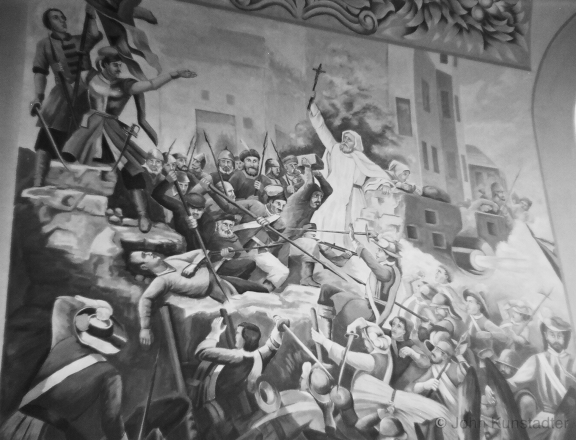Telegram channel Pozirk. Naviny pra Belarus’ (Позірк. Навіны пра Беларусь) reported on February 28 (https://by.tgstat.com/en/channel/@pozirkonline, 28 February 2023 15:24) that the district authorities of Smarhon’ (Смаргонь) in northwestern Belarus have forced the overpainting of a fresco in the chancel of the Roman Catholic church of Our Lady of the Rosary in Soly (Солы).
The fresco in question, painted on the north wall of the chancel in approximately 1934, depicts the Battle of Warsaw, known as the Miracle on the Vistula (Cud nad Wisłą), on August 15, 1920, the feast of the Assumption. With this victory Poland halted the heretofore seemingly unstoppable invading Bolshevik army. The fresco is a fitting one for the church, named as it is for another victory attributed to the intercessory power of the Blessed Virgin Mary, the victory of Christendom over the similarly remorseless Ottoman empire at Lepanto in 1571. In a similar vein, the fresco on the opposite wall depicts the Defense of Czestochowa, the holiest Roman Catholic place in Poland, from the Swedes in 1655.
According to the Pozirk report, the current authorities acted following pressure from (state-owned) Belarusian television, one channel of which attacked the priest in Soly in a January 2022 program and asserted among other things that the fresco is “a call to ignite national and religious enmity”. In other words, in objecting to the anti-Bolshevik nature of the fresco, Belarusian state-run television, and by extension the local authorities, objected to the fresco’s stand against the athiest, expansionist Soviet Union, an entity which — providently — no longer exists. In this way the current authorities have merely repeated an identical act of vandalism on the fresco by the Soviet authorities during their decades-long destructive occupation of the western Belarusian lands.
This act of smearing yet another piece of Belarus’ patrimony raises an important question: does the loss of Belarus’ patrimony during the devastating Muscovite invasions of the 16th, 17th and 18th centuries, during the 12 decades of Russian imperial repressions after the third and final partition of the Polish-Lithuanian Commonwealth in 1795, and during World War I come anywhere close to the loss of its patrimony which Belarus has suffered since the Soviet re-occupation from 1943 onward and the country-wide, deliberate neglect and destruction of patrimony since 1994?
In any case once again personal and parish memory and private archives will outlast all neo-Soviet/Muscovite paintbrushes.
Telegram канал „Позірк. Навіны пра Беларусь“ паведамляў 28-га лютага (https://by.tgstat.com/en/channel/@pozirkonline, 28 February 2023 15:24) пра загад Смаргоньскага райвыканкаму зафарбаваць фрэску 1930-ых гг. пра бітву пад Варшавай („Цуд на Вісле“) у касьцёле Маці Божай Ружанцовай у Солах. Паводле паведамленьня Позірку, райвыканкам прымусіў гэты акт у кантэксце кампаніі дзяржаўнага тэлебачаньня супраць ксяндза ў Солах, у прыватнасці тэлевізійная праграма на тэлеканале “Беларусь 1” у студзені 2022 г., у якой сьцвярджалі, што фрэска “заклікае да распальвання нацыянальнай і рэлігійнай варожасці”. Іншымі словамі сёньняшнія беларускія ўлады абараняюць (дакладна атэістычны й імперскі) Советский Союз, які — дзякуй боскаму провіду — ужо не існуе. Дык гэтыя ўлады проста паўтараюць тое ж пошлае дзеянне супраць той самай фрэскі, якое савецкі акупацыйны рэжым ажыццяваў дзесяцігодзьдзяў таму.
З гэтай нахабнасьці супраць нацыянальнай спадчыны ўзнікае зразумелае, простае пытанне: ці назапашаная страта беларускай спадчыны падчас маскальскіх апрычніцкіх уварваньняў 16-га, 17-га й 18-га стст., падчас 12 дзесяцігодзьдзяў імперскіх рэпрэсій пасьля апошняга радьдзелу Рэчы Паспалітай і падчас Першай сусьветнай вайны набліжаецца ў любым выпадку да назапашанай страты беларускай спадчына с часоў партызанскага зьнішчэньня сядзібаў і іншых забудоў й новай савецкай акупацыі па распад савецкай імперыі й зноў пасьля 1994 г.?
У любым выпадку зноў і асабістая й парафіяльная памяць перажыве ды пераможа любы саўкаўска-маскальскі пэндзаль.
Chancel frescoes from c. 1934 in the Roman Catholic church of Our Lady of the Rosary, Soly 2008.
Фрэскі 1930-ых у касьцёле Маці Божай Ружанцовай, Солы 2008 г.
Now-overpainted fresco of the Polish defeat of the Bolshevik army in the Battle of Warsaw (Miracle on the Vistula), August 15, 1920.
Зараз зафарбаваная фрэска перамогі Польшчы над бальшавіцкай арміяй у бітве пад Варшавай (Цуд на Вісле), 15 жніўня (Унебаўзяцьця) 1920 г.
Fresco of the Defense of Czestochowa against the Swedes in 1655.
Фрэска абароны Чэнстаховы супраць шведаў 1655 г.

